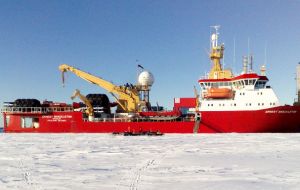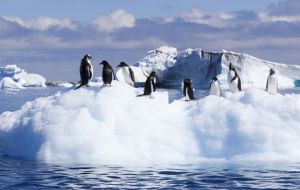MercoPress. South Atlantic News Agency
UK celebrates 25th anniversary of Antarctic Environmental protection treaty
 “The Environmental Protocol is the only international agreement designed to protect an entire continent” pointed out Sir Alan
“The Environmental Protocol is the only international agreement designed to protect an entire continent” pointed out Sir Alan  UK's contribution to the Antarctic Treaty system is decisive with world class science of BAS; the UK Antarctic Heritage Trust and the Royal Navy’s ice patrol vessel
UK's contribution to the Antarctic Treaty system is decisive with world class science of BAS; the UK Antarctic Heritage Trust and the Royal Navy’s ice patrol vessel  Antarctica has been the scene of considerable cooperation between the UK and Argentina, both within the Treaty system and in the field of science
Antarctica has been the scene of considerable cooperation between the UK and Argentina, both within the Treaty system and in the field of science On the twenty fifth anniversary of the Antarctic Treaty Protocol on Environmental Protection, British Minister for Polar Regions, Sir Alan Duncan underlined the hsitoric contribution and role played by the UK in Antarctica and in elaborating the protocol. Sir Duncan also pointed out that Antarctica has been the scene of considerable cooperation between the UK and Argentina, both within the Treaty system and in the field of science, “an area where I hope we may be able to do even more in the coming years”.
“The Environmental Protocol is the only international agreement designed to protect an entire continent. It ensures that all human activity in Antarctica is carefully planned, to enable well-managed, environmentally sensitive tourism alongside scientific endeavor and exploration. And crucially, the Protocol prohibits commercial mining and it protects vulnerable areas, animals and plants”, said Sir Alan.
UK's contribution to the Antarctic Treaty system is decisive through the world class science of the British Antarctic Survey, the enthusiasm and expertise of the UK Antarctic Heritage Trust and the dedicated crew of the Royal Navy’s ice patrol vessel HMS Protector. Other recent milestones include to have climate change included onto the agenda at the annual meetings of Treaty Parties; working with the International Association of Antarctic Tour Operators to develop the first guidelines for visitors to the most visited tourist sites; limiting the spread of non native species to Antarctica, and in enhancing procedures relating to environmental impact assessments.
Only the USA administers more Antarctic protected areas than the UK, but UK manages the largest number of historic sites.
However, insisted Sir Alan, challenges facing Antarctica over the next 25 years cannot be over-stated. Over the second half of the twentieth century, the Antarctic Peninsula was one of the fastest warming regions of the planet. Plastics and heavy metals are now being found in Antarctica in increasing volumes.
Beyond the Protocol, there are other encouraging signs for the future. For example, the Antarctic has been the scene of considerable cooperation between the UK and Argentina, both within the Treaty system and in the field of science, “an area where I hope we may be able to do even more in the coming years”.
Sir Duncan also pointed out that the British Antarctic Territory is the UK’s largest overseas territory and an integral part of Britain's interests in the South Atlantic.
The expansion of Marine Protected Areas is another cause for optimism.
”We must continue to support the Commission for the Conservation of Antarctic Marine Living Resources – mercifully, though not catchily, shortened to CCAMLR (generally pronounced Cam – lar)- in protecting the Antarctic Ocean and the multitude of animals that depend on it for food”.
Finally Sir Alan expressed his delight following the Commission’s October meeting, when after five years of discussion, the world’s largest Marine Protected Area was agreed. It is in the Ross Sea region of Antarctica. It is the second Antarctic Marine Protected Area, joining the one near the South Orkney Islands which was established in 2009 at the instigation of the UK. That is just one part of a network of Marine Protected Areas that the UK is developing across our Overseas Territories, including those around South Georgia, the British Indian Ocean Territory and Pitcairn Island.




Top Comments
Disclaimer & comment rules-

Read all commentsconsiderable cooperation between the UK and Argentina,
Dec 09th, 2016 - 08:51 pm +1Friends, where would we be without friends.
Commenting for this story is now closed.
If you have a Facebook account, become a fan and comment on our Facebook Page!